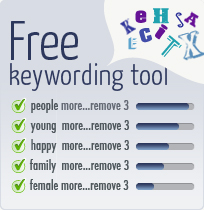 When talking about stock photography there are a few concepts and terms that help to clarify the discussion. Here I have tried to put together the concepts and tools I use when talking about stock among other stock professionals. A lot of the concepts here are unfortunately unknown to a lot of photographers in both micro and macro but are used often at conferences and in talking about stock in general. If you are a professional stock photographer perhaps you should read the “advanced stock theory” instead.
When talking about stock photography there are a few concepts and terms that help to clarify the discussion. Here I have tried to put together the concepts and tools I use when talking about stock among other stock professionals. A lot of the concepts here are unfortunately unknown to a lot of photographers in both micro and macro but are used often at conferences and in talking about stock in general. If you are a professional stock photographer perhaps you should read the “advanced stock theory” instead.
Microstock
Stock agencies selling images at a very low price. Normally around 1USD for a small resolution royalty free license.
Midstock
A term that has been the subject of a lot of controversy. Prices at midstock collections such as the Fotolia Infinity collection, Snapvillage, Featurepics or the 123RF EVO collection are normally 10 USD for a small web resolution and either 50 to 100USD for a ultra high res. Midstock operates with commissions of normally 50% and together with the high prices compared to microstock, these collections are effective ways for a small agency to compete efficiently against bigger agencies that have lower prices and lower commission such as istockphoto.com or shutterstock.com. Midstock normally operates with price-exclusivity (see below).
Macrostock
Macrostock or “traditional stock” describes all the agencies not selling their images at microstock prices, such as Corbis, Getty, JupiterImages, Veer, Alamy, etc. Prices in macrostock have dropped and you can now buy a low res web usage license at Getty for only 49USD. However the prices in macro are much higher than micro and midstock, normally between 50 – 750USD depending on size.
Cannibalization
This term in relation to stock photography covers the idea, that if a photographer suddenly starts selling his images at a much lower price point than before, he will be “cannibalizing” his own ability to make real money from his own higher priced images. The concept of cannibalizing is most often used as a criticism of microstock and it is often said that microstock is cannibalizing the whole macrostock industry by under pricing images too much.
Price point
At a given agency, the lowest price for one royalty free license for one image is it’s starting “price point”. When discussing stock theory, people often say things like “this is too low a price point” or “we should try selling at the lower price points” Price points are often referred to as the lowest price at which you can buy an image. The price point in microstock is therefor normally 1USD, the price point in midstock is 10-20USD and the price point in macrostock is 50USD, but often higher.
Picture Pooling
First used by: Yuri Arcurs
This phenomenon is normally used as a criticism against subscription agencies. It describes the fact that buyers that have a subscription will download more pictures then they use and will sometimes download pictures for future purposes. The result is pools of pictures that the designer can use instead of buying new pictures. Picture pooling is a real threat and it is confirmed by multiple users that if you opt out of subscription selling at Stockxpert for example you will actually earn more almost immediately, despite not getting any income from subscription sales. This can however be caused by more factors then just the result of picture pooling.
Self-pricing
Inventor: Featurepics, Snapvillage among others.
Self-pricing agencies are very popular and basically let the photographers decide at what price point they want to sell their images at, low as well as high prices. Self-pricing is normally between 1USD – 50 USD for the highest resolution file.
Non-exclusive
Non-exclusive agencies and collections allow for the images in them to be sold elsewhere. Normally non-exclusive images don’t have a price-exclusive agreement and you can basically sell the same images at all price points.
Exclusive images
Exclusive images are found on one agency only and cannot be sold elsewhere. The most successful exclusivity program is the iStockphoto exclusivity program or the Getty Collections. This program offers a wide range of extra benefits for the exclusive photographer, such as higher commission, faster inspections, etc. The iStock exclusivity program requires not only the images, but also the photographers themselves to be completely exclusive in the sense that the photographer is not allowed to sell Royalty Free stock for any other agency accept Getty.
Photographer exclusivity
Photographer exclusivity occurs when a photographer chooses to sign a contract forbidding him to produce stock material for any other agency. Normally he receives special benefits for doing so, but it is very criticized and very dangerous because the income is limited to one agency only, so if that agency falls back in sales, the photographer will experience a drop in income, but is bound to stay with that agency. Some photographers report having gone from making as much as 30000USD per month to 3000USD per month in less then two months in exclussive collections.
Price exclusive
Price exclusive images are images that belong to a collection that are not allowed to be sold at a lower price then the price they have in this collection. The Fotolia Infinite collection is a price exclusive collection, and will not allow that you sell the images at other agencies at a lower price. Price exclusive images are non-exclusive, but just price exclusive.
Duplication/plagiarism
Plagiarism is a very controversial subject. When a photographer is looking for new images to produce it is very normal to get “inspiration” from another photographers. Sometimes however, photographers will go a little too far in this endeavour and duplicate another photographer’s pictures a little too much, being that the resemblance is simply too similar to the original. This causes great debates and forum tantrums and can cause a great deal of heat among photographers. Before you accuse someone of duplicating your images, make sure you really are the first one to have come up with the concept and that the other image really is similar to yours. For example, if the accused duplicator has also duplicated your titles and keywords too, this is a good indicator of intentional plagiarism. Stock photographers in microstock will re-invent a lot of concept that have already been thought of and been well executed in traditional stock. These new “inventors” in microstock will then claim and believe they are the original inventors of this concept and think that everyone is duplicating them. The most controversial and talked about duplication case is for sure the “jumping goldfish” from iStock and the most duplicated photographers are Andres Rodriguez, Yuri Arcurs and Lise Gagne from iStock.
Technical quality vs aesthetic quality
Technical quality describes a photographer’s ability to control and produce digital images without well known and defined technical mistakes such as fringing, artifacts, shaken focal point, flare, moire, etc. The aesthetic quality refers to all the aspect that makes a photograph interesting: the conceptual, emotional and creative elements of the image. The lowest degree of technical quality is often found on amateur forums such as diviantart.com or flickr.com, while the highest technical quality is found on iStockphoto. IStockphoto has far more strict technical quality standards than any place in macrostock, despite the much higher prices. The ability to produce high aesthetically pleasing images that also have high technical quality is what defines the difference between the amateur and the professional. Places like iStock, with extremely high technical standards, are often criticized for being too straight and rejecting too many images that have high aesthetically quality but not “perfect” technical quality.
Forum slang / acronyms for photography related forums:
LCV – Limited Commercial Value PM – Private Massage HDR – High Dynamic Range SUB – Subscription lisences. MR – Model Release. RM – Right maneges licences. RR – Rights-Ready RF – Royalty Free licences. OOF – Out Of Focus DOF – Depth of Field OD: On Demand Sale DL – Subscription Sale EL – Extended Licence Sale BME – Best month ever (sales) WME – Worst month ever (sales) BDE – Best day ever (sales) WDE – Worst day ever (sales) Inspectors/reviewers/bouncers/editors/curators/creative content team are all words for the same Agency slang: G: Getty images SV or just “snap”: Snapvillage. IS: Istock.com AL: Alamy.com SXP: Stockxpert.com SS: Shutterstock.com CS: Crestock.com DT: Dreamstime.com FT: Fotolia.com BS: Bigstockphoto.com YAY: YayMicro.com P5: www.pond5.com Thanks to hhltdave5, lilcrazyfuzzy and riffmax for providing more acronyms.Related Reading: Advanced Stock Photography Terminology



















Very interest post and terms specialy “Cannibalization”. I’m finding myself in this term and soon will consider my price structure… Now all my portfolio on FL prices are $1 and ex. price $10 for test period and gues what, sales are same when was price for ex. licence arond $30-40.
Regards,
.shock
Does anyone have the real name of the agency that goes under P5?
Thanks “varius” from SS. http://www.pond5.com.
Very well covered, I can’t think of any more that haven’t been mentioned. It’s sort of rejection reason that most of us have gotten at least once in our lives: how about CA for “chromatic aberation” or purple fringing? That’s all I can think of. Good stuff Yuri 🙂
I am looking to expand from just iStock, and am wondering if selling on a site like Shutterstock, which is cheaper per image, will cannibalize my iStock account? Do buyers often use more than one microstock site find images?